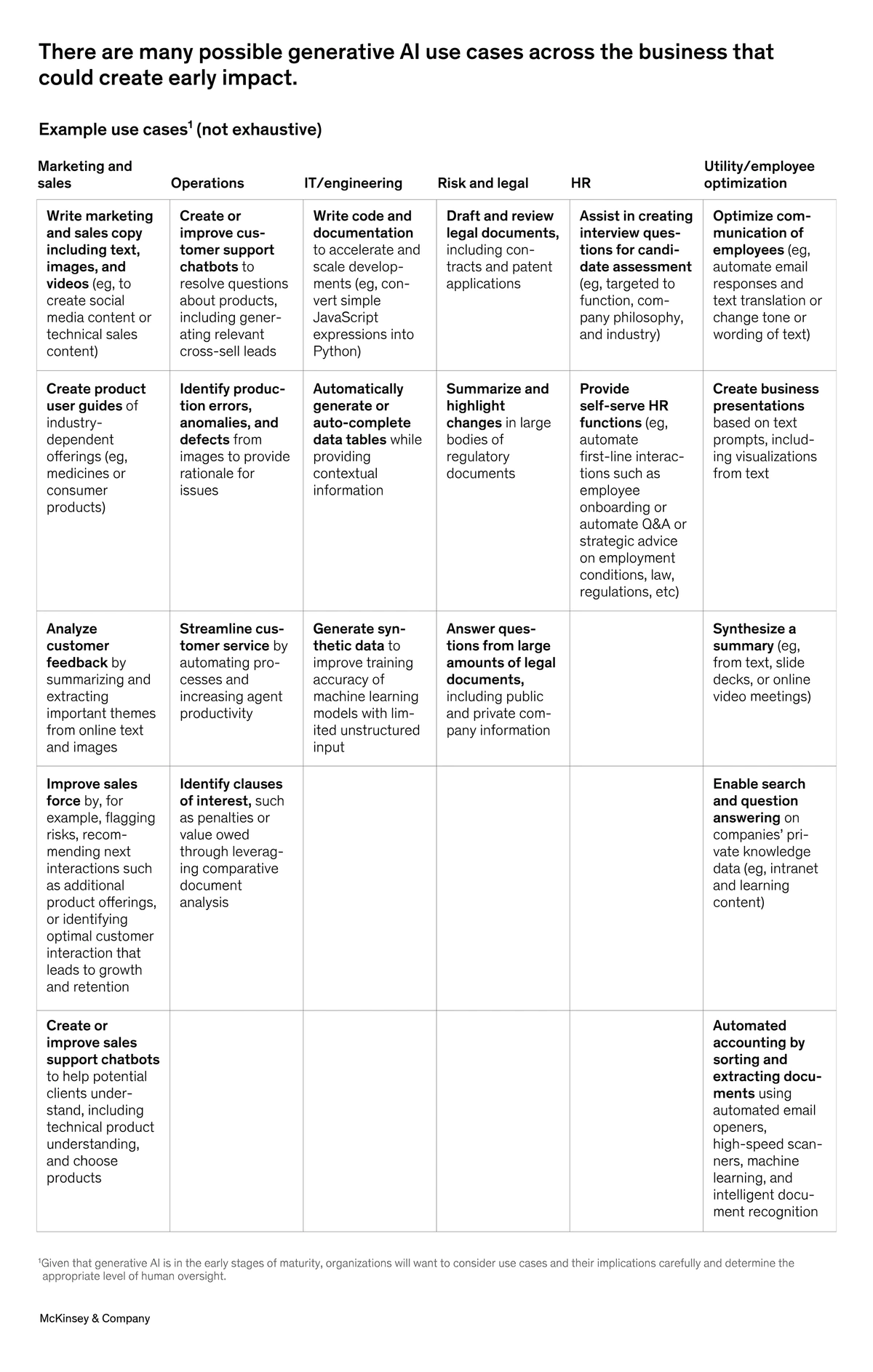Intelligent Innovation … from Amazon to Dreambox, logistics and healthcare … how AI to revolutionising, accelerating and personalising every type of innovation
August 25, 2023

AI has the power to drive radical new innovation through its ability to analyse vast amounts of data, identify patterns, and generate insights that humans might not easily discern.
The recent advances in generative AI to create new content – to reimagine works of art, to create the best pop songs, or write a novel in minutes – are just some examples of its potential.
ChatGPT (the GPT stands for generative pretrained transformer), developed by OpenAI, gained over a million signups in just five days when launched to the public in late November 2022.
For the last decade “traditional” AI has become a super efficient way to analyse and interpret information. It’s commercial applications range from Alexa and Siri, to Waymo navigation system that will drive your driverless car, Amazon’s shopping recommendations, Google maps, or Dreambox’ personalised education platform.
Now “generative AI”, like ChatGPT, has made AI more creative. It not only analyses data, but creates new data, new content. While traditional AI excels at pattern recognition, generative AI excels at pattern creation.
AI’s progress is accelerating at incredible pace, its potential becoming more apparent everyday, but also with increasing concerns. Mustafa Suleyman founded Google’s Deepmind, an AI pioneer business, and more recently Inflection AI, which has created a personal chatbot, Pi. In his new book The Coming Wave, he discusses the opportunities and challenges:
Some of the major applications of AI in driving innovation include:
- Data Analysis and Insights Generation: AI can process large datasets quickly and efficiently, uncovering hidden patterns and trends that can lead to innovative insights. This can be applied in various fields, such as healthcare, finance, and marketing, to make informed decisions and develop new strategies.
- Automation and Efficiency: AI-powered automation can streamline tasks that are repetitive and time-consuming for humans. This frees up human resources to focus on more creative and strategic aspects of their work, leading to the development of new ideas and approaches.
- Personalization: AI enables the creation of highly personalized experiences for users. Whether in e-commerce, entertainment, or healthcare, AI algorithms can analyze user behavior and preferences to offer tailored recommendations, products, or services that match individual needs.
- Product and Service Innovation: AI can be used to create entirely new products and services that were previously not possible. For example, the development of self-driving cars, virtual assistants, and personalized medicine are all innovations made possible by AI technology.
- Predictive Analytics: AI can predict future trends and outcomes based on historical data and current patterns. This can assist businesses in making proactive decisions and developing strategies that are ahead of the curve.
- Scientific Discovery: In fields like drug discovery and materials science, AI can analyze complex molecular interactions and simulations, leading to the identification of new compounds and materials that have the potential to revolutionize industries.
- Creative Content Generation: AI algorithms can assist in generating creative content such as art, music, and literature. While not entirely replacing human creativity, AI tools can provide inspiration and novel starting points for artists and creators.
- Natural Language Processing: AI-powered language models can understand and generate human language. This is being used in customer service chatbots, language translation, content generation, and more, contributing to efficiency and global connectivity.
- Healthcare Innovations: AI can analyze medical images, genetic data, and patient records to assist in disease diagnosis, treatment optimization, and drug discovery. This can lead to personalized medicine and improved patient outcomes.
- Environmental Impact: AI can be employed to optimize resource utilization, monitor pollution, and analyze climate data. It plays a crucial role in developing sustainable solutions and mitigating environmental challenges.
- Research and Development: AI can accelerate research by performing complex simulations and experiments in silico, reducing the time and cost required for developing new technologies and products.
- Supply Chain Optimization: AI can enhance supply chain operations by predicting demand, optimizing logistics, and reducing waste, ultimately leading to more efficient and sustainable processes.

Indeed, AI serves as a powerful tool that complements human capabilities, enabling us to innovate faster, make better decisions, and address challenges in ways that were previously unimaginable. At the same, we need to continue to explore and address ethical and societal implications while harnessing the power of AI-driven innovation.
Here are some more real-world examples of how AI is driving new, radical innovation in every sector:
Healthcare:
- Medical Imaging Analysis: AI algorithms, like those developed by companies like Enlitic and Aidoc, can analyze medical images (X-rays, MRIs, CT scans) to assist radiologists in detecting diseases like cancer at an early stage.
- Drug Discovery: Companies like Atomwise use AI to predict the effectiveness of potential drug compounds, accelerating the drug discovery process.
- Personalized Treatment: IBM Watson for Oncology provides personalized treatment recommendations for cancer patients by analyzing vast amounts of medical literature and patient records.
Finance:
- Algorithmic Trading: AI-driven algorithms analyze market data to make high-speed trading decisions, improving efficiency and accuracy.
- Fraud Detection: AI models, such as those used by companies like Feedzai, can detect fraudulent transactions in real-time by identifying patterns and anomalies in financial data.
Transport:
- Autonomous Vehicles: Companies like Waymo and Tesla are developing self-driving cars that use AI to navigate and make real-time decisions, potentially revolutionizing the future of transportation.
- Traffic Management: AI-powered traffic management systems, like those in some cities, optimize traffic flow and reduce congestion based on real-time data. Consider Alibaba’s CityBrain.
Retail:
- Recommendation Systems: E-commerce platforms like Amazon and Netflix use AI to provide personalized recommendations to users, enhancing user experience and increasing sales.
- Visual Search: AI-powered visual search tools allow users to search for products by uploading images, improving the shopping experience.
Manufacturing:
- Predictive Maintenance: AI-enabled sensors can monitor machinery health and predict maintenance needs, reducing downtime and optimizing production processes.
- Quality Control: AI-powered computer vision systems can detect defects in manufacturing processes, ensuring higher product quality.
Education:
- Personalized Learning: AI-driven educational platforms, like DreamBox, adapt content and learning paths to individual students’ needs, improving learning outcomes.
- Language Learning: Apps like Duolingo use AI to personalize language learning experiences and adapt lessons to individual proficiency levels.
Energy:
- Energy Optimization: AI algorithms can optimize energy consumption in buildings, factories, and cities, contributing to energy efficiency and sustainability.
- Climate Modeling: AI models analyze climate data to predict and understand climate change trends, aiding in environmental planning and policy-making.
Entertainment:
- Content Creation: AI-generated art, music, and even writing have emerged as innovative creative tools, such as Jukedeck for music composition.
- Video Game Design: AI can assist in generating game levels, characters, and narratives, enhancing game development processes.
Just a few examples highlighting how AI technologies are driving innovation across diverse sectors, improving efficiency, enabling new capabilities, and creating entirely new opportunities for growth and advancement.
More from the blog